Abstract
Organizational behavior examines the interactions of individuals and groups within businesses, while human resource management (HRM) focuses on enhancing workforce efficiency through recruitment, training, and employee relations. The success of an organization depends on the relationship between employee engagement and performance, as engaged individuals enhance productivity and innovation. This study aims to conduct a comprehensive bibliometric analysis of the academic research on the relationship between artificial intelligence (AI), employee engagement, and performance. This study highlights trends, countries, sources, and keywords in this field. The authors analyzed 11,291 articles in the first phase, 42,358 articles were analyzed in the second phase, and 606 articles were analyzed in the third phase. This study highlights the growth of the research in this area and identifies the most productive years and regional contributions. The citation analysis is used to identify the relevant research and renowned authors. This study also addresses ethical concerns related to the implementation of artificial intelligence (AI) in the workplace. This study indicates theme variations among national contributions, highlighting differing socio-cultural and theoretical perspectives on AI adoption in HRM, from behavioral leadership models to efficiency-oriented frameworks. In summary, this bibliometric study provides valuable insights into the evolution of the research topics related to AI’s impact on employee engagement and productivity, spanning multiple disciplines, such as psychology, organizational behavior, and computer science. It is relevant for the researchers, practitioners, and businesses interested in understanding and utilizing AI in the workplace.
1. Introduction
Human resource management (HRM) is the organization’s function for overseeing and enhancing the company’s workforce. Its scope includes compensation, employee relations, recruitment, and training programs to ensure that employees contribute effectively towards achieving the company’s goals [1]. Organizational behavior is a field that examines how individuals and groups behave within the context of an organization. It delves into motivation, leadership, communication, and team dynamics to understand their impact on employee engagement, performance, and workplace effectiveness [2]. Organizational behavior and employee engagement and performance are subfields of both “Human Resource Management” (HRM) and “Organizational Behavior” [3]. These concepts are fundamental to how firms manage and engage with their workforces to maximize employee happiness, productivity, and efficiency in the workplace [4]. Both are fundamental to studying human resource management (HRM), which optimizes an organization’s human resources to achieve its strategic goals and objectives. These concepts also relate to the study of organizational behavior, which delves into the interplay between individual and group actions inside a business. Consider leadership, culture, and motivation’s roles in shaping employee engagement and output [5].
Employee engagement, characterized by the emotional and cognitive commitment of employees to their roles, significantly influences the effectiveness with which organizations achieve their strategic objectives. Collectively, these dimensions constitute a fundamental element of good human resource management (HRM) and organizational behavior (OB). The concept of employee engagement and the link between engagement and performance has grown over the past few decades. At its inception in the middle of the 20th century, employee engagement was primarily centered on job satisfaction and motivation [6]. The 1990s saw the birth of theories highlighting the importance of employee engagement in boosting productivity, creativity, and overall business performance. Since then, there has been a push to foster a more engaged workforce through strategic leadership, constructive criticism, and emphasis on employee health and happiness to achieve the company’s long-term goals [7]. The cornerstone for productivity, profitability, and long-term sustainability in today’s dynamic business environment is the symbiotic relationship between employee engagement and performance [8].
Productivity, innovation, contentment in one’s employment, and overall organizational success are all components of employee performance. Companies must deeply comprehend the relationship between employee engagement and performance to thrive in today’s dynamic business environment marked by rapid technological development, shifting demographics, and rising employee expectations. Employee performance directly impacts a company’s ability to innovate, adapt to change, and remain competitive [9]. Thus, businesses are constantly seeking ways to boost their workers’ output. It is necessary to inquire to what extent employee engagement can catalyze increased employee performance and how firms can effectively nurture and harness this connection. This study investigates the causes, outcomes, and contextual factors contributing to the correlation between engaged and productive employees. The close connection between the two is also explored in this study. By doing so, it hopes to aid business leaders and policymakers in pursuing higher productivity and greater employee satisfaction by providing a complete picture of organizational dynamics [10].
Artificial intelligence (AI) integration has emerged as a revolutionary force in modern organizational dynamics and workforce management, transforming how work is conducted and experienced [11]. The fourth industrial revolution began in the late 19th century and is credited with initiating this trend. Artificial intelligence (AI) has not only begun to alter the dynamics of work performance and employee engagement radically, but it has also revolutionized traditional business procedures like machine learning, data analytics, and automation [12]. This is because AI includes data analytics, automation, and machine learning. In the age of AI, organizational success is profoundly affected by employee engagement and performance. Understanding the relationship between AI adoption and employee behavior is essential as organizations experience digital transformation. It has long been acknowledged that employee engagement, defined as the emotional and mental commitment to one’s work, may substantially enhance productivity and creativity. It is essential to undertake a comprehensive analysis of the effects of AI technologies on human resource management (HRM) as their prevalence increases. This research investigates the development of the interplay of AI, employee engagement, and performance via an extensive bibliometric analysis. The purpose is to depict the research environment, discern trends, and examine the capacity of transformational leadership to alleviate the impact of AI on organizational outcomes. Although extensive research exists on engagement and performance, limited studies examine AI as a transformative factor rather than only an ancillary feature. This gap includes a scarcity of bibliometric studies that analyze regional research trends, conceptual frameworks, and the development of keywords in this domain. The increasing prevalence of AI systems in the workplace makes studying their effects on human labor all the more critical. The convergence of artificial intelligence (AI) with these human-centric fields signifies a notable transformation in workforce dynamics. As AI transforms corporate operations via automation, data analytics, and predictive modeling, it is crucial to comprehend its effects on employee experience, motivation, and productivity. Although the literature on employee engagement and performance is plentiful, much of it predates the AI revolution or considers AI as a secondary element rather than a transformative influence. However, it is also crucial to recognize leadership’s role in shaping and guiding this transformation. This study aims to examine how AI impacts productivity in the workplace and how it affects workers’ enthusiasm for their jobs by focusing on the role of transformational leadership as a moderator [13]. AI technologies have become vital across many sectors because of their ability to boost output, cut down on mistakes, and introduce novel opportunities. However, others are worried about the effects that the widespread use of AI systems in the workplace could have on human workers. Are increased output and job satisfaction the outcomes of AI systems, or do they raise concerns about making human employment obsolete? In answering these questions, many aspects come into play, with leadership style emerging as a critical component in determining the results of AI integration. The leadership style known as transformational leadership, which is characterized by an inspirational and visionary approach, has been recognized for its ability to inspire employee loyalty and commitment. It encourages novel ideas, flexibility, and a positive company culture—all important in implementing AI [14].
Therefore, it is crucial to investigate how much of a moderating role transformational leadership has in the connection between AI implementation, job performance, and employee engagement. This study aims to contribute to the ongoing discussion of AI in the workplace by exploring the relationship between AI, productivity at work, employee engagement, and management style. In doing so, it intends to provide helpful information for business executives and legislators as they adapt to an increasingly AI-dominated business landscape. The following paragraphs will provide a more in-depth knowledge of the complex dynamics at play in today’s workplaces through a review of the relevant literature, the research methodology used, the analysis of the data, and the implications of this study’s findings.
1.1. Research Gap in This Study
The impact of AI on overall employee engagement and performance remains a significant gap in the literature, despite the rapid proliferation of AI technology within enterprises. The majority of the current research examines these variables in isolation, concentrating on either the conventional relationship between engagement and performance or the operational impacts of AI on enterprises. There is a scarcity of research that investigates AI as a transformative element in human resource management, as opposed to a supplementary instrument. In numerous domains, bibliometric studies have become increasingly popular for the purpose of delineating knowledge hierarchies; however, there are few studies that explicitly investigate the interaction between AI, employee engagement, and performance. The majority of bibliometric assessments fail to demonstrate the extent to which technological disruptions, particularly artificial intelligence, have impacted the research topics, author networks, and conceptual trends. Additionally, the quantitative and bibliometric research has yet to investigate the role of transformational leadership as a mediator or moderator in AI-integrated workplaces, despite the universal recognition that it improves engagement and performance. Because AI is dual in nature, it encompasses both beneficial and detrimental aspects, this disparity is especially significant. It has the potential to improve efficiency, offer personalized services, and provide predictive insights; however, it may also result in job displacement, diminish the human element of work, and create ethical quandaries. Without a systematic analysis of the existing literature and empirical data regarding keyword evolution and publishing trends, organizations and researchers are unable to comprehend, anticipate, and steer the future of AI-enhanced workforce efforts.
1.2. Theoretical and Practical Contributions
This study offers several important theoretical and practical contributions to the continuing discussion about the influence of AI on employee engagement and performance. It synthesizes insights from computer science, business, and psychology to create a holistic framework for understanding how AI is transforming human collaboration. This research expands existing theories of organizational behavior and human resources, which have mainly focused on interpersonal interactions, to include the effects of algorithmic decision-making, data-driven feedback loops, and intelligent automation. One of the main contributions is that it transforms our understanding of employee engagement, viewing it not merely as an emotional and cognitive construct, but also as one increasingly shaped by digital interfaces and AI-driven interventions. This study enhances the leadership theory by illustrating how transformational leadership can affect employee behavior in AI-enabled environments, alongside the influence of visionary and empathetic leadership on their reactions to technological progress. This paper improves methodologies by creating and utilizing a comprehensive, three-phase bibliometric analysis model that can act as a framework for future research across several fields. This research offers HR practitioners, corporate leaders, and legislators critical information on the implementation of AI technology while safeguarding employee well-being and engagement. It offers evidence-based approaches for creating AI-driven systems that align with human-centered principles, including psychological safety, fairness, and trustworthiness. The findings may aid corporate executives in executing transformative leadership styles that emphasize flexibility and creativity, while concurrently addressing employees’ apprehensions about automation and job security. This research offers essential insights for the formulation of training and upskilling initiatives to equip employees for the utilization of AI. It also illustrates the importance of leadership development programs that prepare managers with the essential abilities to function as change agents in digitally transforming organizations. This research offers policymakers and organizational strategists a paradigm for establishing ethical AI governance that takes into account the social, emotional, and cultural dimensions of technology utilization. This research enhances our understanding of developing high-performing, engaged, and resilient workforces in an era of rising intelligent technologies.
1.3. Research Objectives
The objective of this study utilizes a three-phase bibliometric analysis based on data from the Scopus database to perform the following actions:
- To examine the evolution of employee engagement and performance research over the years by analyzing publication trends, prominent sources, and influential studies.
- To identify the contributions of various nations, institutions, and authors in advancing the field of employee engagement and performance.
- To determine the most cited AI-based publications in employee engagement and performance research, highlighting their impact on the academic community.
- To explore patterns and trends in author-assigned keywords, providing insights into evolving research themes, priorities, and interdisciplinary connections within the field.
This study will conduct a comprehensive literature review on employee engagement and performance with the mediating role of AI, investigate the various models and theories associated with these concepts, and analyze empirical studies highlighting the importance of the relationship between these two factors. Today, the relationship between employee engagement and corporate success is paramount when businesses are under increasing pressure to retain talent and remain competitive. This paper aims to add new, useful information to the ongoing conversation, pointing businesses toward more efficient approaches to fostering an atmosphere where workers are enthusiastic about their jobs and committed to producing results that stand out in an increasingly competitive global economy. The findings are anticipated to indicate an increase in publications concerning AI, engagement, and performance, a predominance of contributions from specific nations, and a significant correlation between transformative leadership and favorable AI outcomes. These insights will delineate a framework for the forthcoming research and present pragmatic implications for technology-oriented personnel management. This study’s methodology, data collection, and analytic methods their implications for organizations are provided in the various sections of the article.
2. Importance of Employee Engagement and Work Performance
Employees who care about their employment and the firm’s success are more likely to put in extra effort. Therefore, they must be engaged and perform well. Employees who consistently exceed expectations can significantly impact the bottom line. Employees invested in their work are more likely to propose original solutions. Because of their dedication, organizations foster an environment where new ideas are encouraged and welcomed, which is crucial in today’s fast-paced corporate world. Participating workers are more likely to be content with their jobs. Financial savings, continuity of service, and morale all benefit from low employee turnover [15]. Employees who enjoy their work are more likely to go above and beyond for their customers. Companies that truly value their customers go the extra mile for them. This results in increased customer satisfaction and loyalty. Employees who are invested in their work are more likely to be flexible and open to new ideas, two qualities that are essential in today’s ever-evolving global economy. Their efforts contribute directly to the overall success of the company. It is common practice to equate happy workers with happy employers [16]. Worker engagement is associated with lower rates of stress, burnout, and other health issues, leading to fewer sick days and lower healthcare costs. A sustainable competitive advantage can be built on the backs of highly engaged and productive workers. They keep things moving, and their commitment to the cause could alter the playing field. The workplace can be more pleasant for everyone involved when employee engagement and output are high. This then draws in the best possible candidates, continuing the cycle of success. In today’s complex and competitive economic climate, companies that wish to succeed cannot ignore the correlation between employee enthusiasm and productivity. A healthy and dynamic workplace that is adaptable to change and promotes long-term success can be developed through employee participation and the supply of required resources. This leads to enhanced productivity and drives it [17].
3. State of the Art
Over the past decades, employee engagement and performance have been widely explored, but the growing complexity of work environments—especially under the influence of AI—demands a deeper, more critical understanding of their interrelationships. Employee engagement is often conceptualized as a multidimensional construct encompassing vigor, dedication, and absorption [18]. While consensus exists on its positive correlation with performance indicators, such as productivity, creativity, and organizational commitment [19], studies diverge in how they define and measure these constructs, as well as the mediating variables involved. A significant body of research confirms that transformational leadership enhances both engagement and performance [20]. However, some studies emphasize organizational culture and job autonomy as equally critical moderators, suggesting a contextual dependency that prior studies have often overlooked. For instance, while trust and communication are recognized as universal antecedents of engagement, their operationalization varies across cultural and organizational settings, leading to inconsistent findings. Critically, the influence of AI as a disruptive technology in the workplace remains underexplored in the HR literature. Although emerging work acknowledges AI’s role in redefining roles and workflows [11], there is limited consensus on whether AI-driven transformation fosters or hinders employee engagement. This ambiguity underscores a substantial research gap: few studies holistically examine how AI integration interacts with leadership styles and organizational support to impact employee performance outcomes. Furthermore, despite substantial descriptive literature, few bibliometric studies have quantitatively mapped the evolution of this research area. As a result, the field lacks a consolidated view of scholarly influence, global trends, or the interdisciplinary connections that shape our current understanding.
Recent studies have investigated the effects of technical improvements and working arrangements that allow employees to work remotely on employee engagement and performance. It is abundantly clear that new approaches are required to retain engagement and performance in light of these developments. The analysis of the relevant literature reveals a clear and strong link between the level of employee engagement and the performance of an organization. Employees engaged in their work are likelier to be devoted, productive, and content with their jobs. The leadership of an organization, the culture of that organization, and the many HR initiatives all play significant roles in cultivating and maintaining employee engagement [21]. For businesses that want to improve their overall performance and achieve lasting success, it is crucial to understand and use this relationship.
RQ1: How has the landscape of employee engagement and performance evolved over the years, and what insights can be gained from detailed years and source analysis?
RQ2: What conceptual and thematic differences emerge across national research contributions on employee engagement and performance in AI-integrated workplaces, and how do these reflect regional theoretical or methodological orientations?
RQ3: Which AI-based employee engagement and performance research publications have received the most citations and significantly influenced the research community?
RQ4: What patterns and insights can be derived from an in-depth analysis of author-assigned keywords across a selected body of literature, and how do these keywords reflect evolving trends, research priorities, and interdisciplinary connections within the field?
4. Proposed Methodology
Analytics is essential for analyzing the results, and different methods are used for a wide-ranging quantitative and qualitative literature study [22]. One kind of scientific mapping, a scientometric review, seeks to identify and examine emergent patterns and trends in a particular field [23,24]. Data regarding websites, webpages, and other types of content relevant to a specific topic can be gleaned via studies conducted in Webometrics and cybernetics [25,26]. Altmetrics is a technique that is used to check to measure the social impact of a published article on social media like Twitter, Facebook, etc., to identify the social media mentions, downloads, and shares to understand the influence of the study [27,28]. Bibliographic analysis involves systematically examining bibliographic information, such as publication trends, citation patterns, journal analysis, and countries’ contributions, to gain insights into the scholarly landscape and the evolution of knowledge within a specific field or topic [29]. This study’s methodology is depicted in Figure 1; it centers on a bibliometric examination of employee engagement and performance.
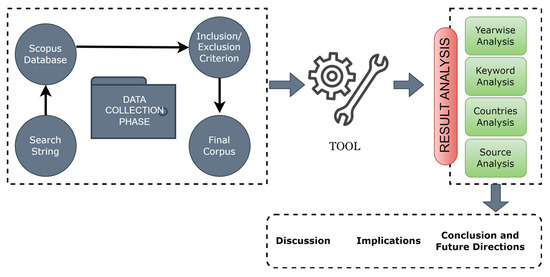
Figure 1.
Proposed methodology.
The visualization networks and visual analysis results are presented in Excel and VOSviewer 1.6.20 to further illuminate the research priorities and development tendencies [30,31]. VOSviewer is a freely available, open source software for all users, a popular tool for visualizing bibliometric data for visualizing and analyzing bibliometric data. This tool will help analyze the interconnection between the various modules of an article, like the country, journal, keywords, etc., and visualize the same through graphs and maps [32]. This approach to analyzing the data of the software this tool is widely used and most popular when it comes to the bibliometric analysis [33,34]. The Scopus database was chosen for the bibliometric analysis in this study since it is the most reputable and comprehensive database of scholarly literature [35]. The journals that make up Scopus are of the highest possible quality and are commonly regarded as the “gold standard” in their respective fields. Globally, the Scopus database is followed by researchers to study their domain due to its wide collection of articles. The key focus of this research is to see the analysis of employee engagement and performance based on various parameters. In addition, the author focuses on the relationship between employee engagement and performance in the collaboration of AI. In this study, the research was conducted in three phases. In the first phase, employee engagement was analyzed, and furthermore, in the second section, a discussion on employee performance was conducted.
Furthermore, in the final phase, the strings were combined, and AI keywords were used to extract the data. Finally, the role of AI in employee engagement and performance was analyzed using the Scopus extracted data. This study investigates the following bibliometric indicators from the extracted data from Scopus, which help the authors analyze the data and provide different findings from that [36,37].
- i.
- Publication count and its growth.
- ii.
- Top sources to publish the articles.
- iii.
- Subject areas that contribute to the research.
- iv.
- Leading countries contribute to the research in terms of documents and citations.
- v.
- Keyword analysis to predict the trends.
Data selection and finalization in this investigation followed the procedure outlined in Table 1.

Table 1.
String and corpus selection.
In Table 1, the author represents the string selection and final corpus used for the analysis. In this study, string was passed to the Scopus database, and the initial count was provided. Furthermore, the authors applied inclusion/exclusion criteria in which only English-written articles were considered. After removing those articles, the final corpus count was provided, which was used for the analysis. In the first pass, the author passed the string (TITLE-ABS-KEY((“employee” AND “engagement”))) to the Scopus database, which is widely regarded as the most comprehensive and trustworthy of all the databases that contain published papers [38]. In the first pass, the author received 11,551 articles and applied the inclusion/exclusion criteria in which only English-language articles were considered. After applying the criteria, 11,291 articles were considered as the final number as our research objective was to determine the involvement the artificial intelligence in employee engagement; so, the author passed the string (TITLE-ABS-KEY((“employee” AND “engagement”) AND (“Artificial Intelligence” OR “AI”))) to the Scopus database. Figure 2 represents the phase-wise process.
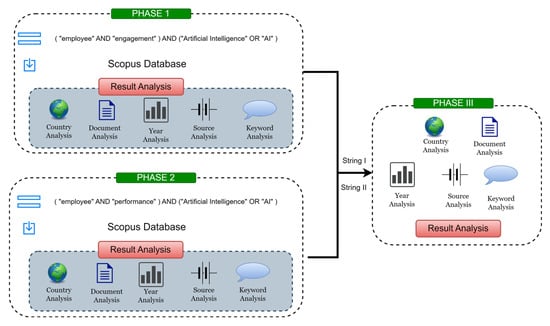
Figure 2.
Result analysis process.
4.1. Phase I: Employee Engagement
In the first step, the authors used the keyword “employee engagement” to obtain relevant information from Scopus, one of the largest and most trustworthy databases. To extract the data, the (TITLE-ABS-KEY((“employee” AND “engagement”))) string was passed to the Scopus database. The initial database extraction process provided 11,551 articles. The authors then applied inclusion/exclusion criteria to the extracted data, excluding papers without complete metadata (author, year, title, etc.) and selecting only those written in English and published in journals and conferences. A total of 11,291 articles were considered for this study. The authors conduct an in-depth analysis here to address this study’s research questions.
4.1.1. Publication Timeline Analysis
Figure 3 shows a publication timeline (1937–2010) trend over the years for employee engagement, and Figure 4 shows the publication timeline from 2011 to 2023. The publication on the employee engagement theme started in 1937 with one publication, and as represented, this publication number increased with time. The year 2022 saw the maximum number of publications at 1513, which is 13.4% of total publications. The data were taken till the third quarter of the year 2023; until that time, 1369 articles were published. More articles in this domain will be published in the coming years.
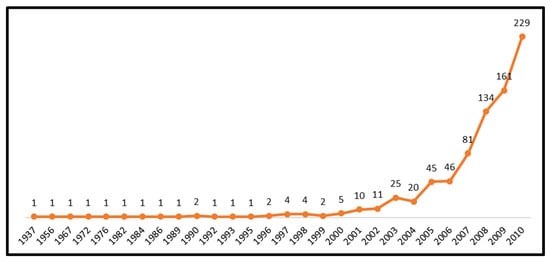
Figure 3.
Publication timeline (1937–2010) of phase I.
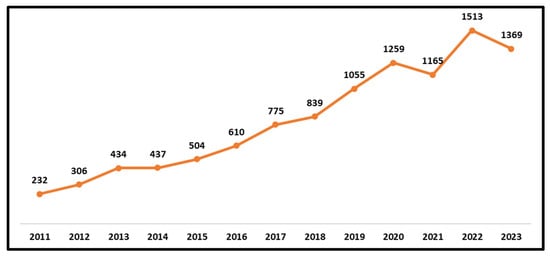
Figure 4.
Publication timeline (2011–2023) of phase I.
4.1.2. Subject-Wise Analysis
Figure 5 illustrates the growing trends that relate to the subject area. It is clear from these data that studies in various fields are to be anticipated. Most articles on the topic can be found in the business, management, and accounting section, as this is a management responsibility. This paper appeared in many publications, including those devoted to psychology, economics, finance, engineering, etc.

Figure 5.
Subject area analysis in phase I.
4.1.3. Type of Source Analysis
Figure 6 represents a source-wise rising trend. A total of 9352 articles are published in journals, 82.82% of the total publications. In journals, 3853 articles are published on open access platforms, which is 34.12% of the publications. There are 1750 gold, open access, 526 hybrid, 658 bronze, and 2572 green publications.
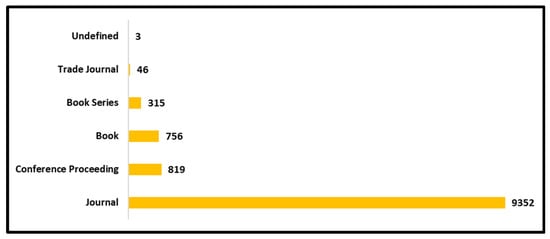
Figure 6.
Source-wise analysis in phase I.
4.1.4. Journal-Wise Analysis
The graphical representation for the research publication based on the journals and conferences is represented in Figure 7. This method can also be used to analyze the journals’ citations profiles. This bar chart was used to create article counts, journal citations, and the journals’ or conferences’ impact factor, which was collected from the websites of the journals in May 2025. According to the data, the Frontiers in Psychology journal is in the lead with 217 articles. This journal has an impact factor of 2.6. The Journal of Environmental Research and Public Health is second on the board with 189 publications. This journal has an impact factor of 4.6.
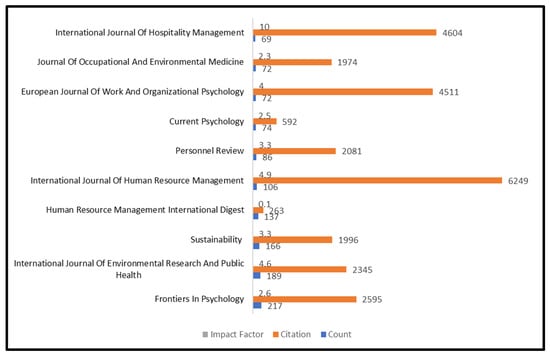
Figure 7.
Journal analysis in phase I.
4.1.5. Country Analysis
The corpus selected for analysis consisted of 11,291 articles, and the analysis shows the countries contributing to the field. Table 2 represents the analysis of countries with respect to their publications and citations. The analysis shows that the United States is in the lead with 2825 articles and a citation count of 80,508 when it comes to the number of publications and based on the citations. The United States has a link strength of 1072. The United Kingdom is positioned in second place with 1140 publications and 24,629 citations in publications, and comes third for citations. Regarding citations, the Netherlands leads the board in the second position with 614 articles and 50,125 citations. India is in third position with 991 articles.

Table 2.
Countries’ contribution based on the publications and citations in phase I.
According to their research papers, the network diagram of countries is shown in Figure 8. Each link is provided a positive numeric value representing its “link strength.” The higher this number is, the tighter the bond. The link strength between the two keywords is represented by the number of times the two keywords appear together in a publication. Figure 8 displays the results of this research, which shows that the United States has the most publications (2825), the most citations (80,508), and the most robust links (1072).
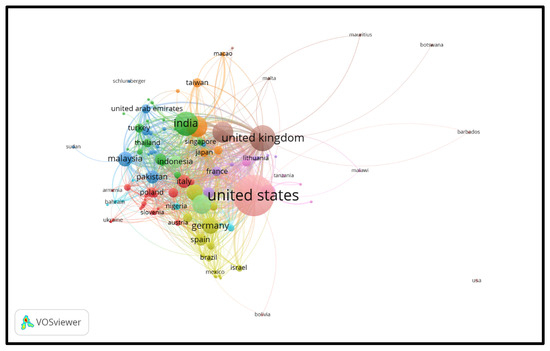
Figure 8.
Countries’ network connection in phase I.
4.1.6. Keyword Analysis
Figure 9 visually represents the most frequently used keywords by the authors in their research studies. The analysis highlights the keywords based on the number of times they appear across various publications. This graphical depiction helps in identifying the core focus areas and recurring themes within the field. The prominence of each keyword reflects its relevance and significance in the context of employee engagement research. There are 2477 occurrences of the keyword “Employee Engagement,” and the connection strength between these instances is 8647. Figure 10 shows the results of the article’s keyword network analysis. Many different researchers have utilized the terms “work engagement,” “human,” “employee engagement,” “humans,” and “article” in their studies. These are the top-tier keywords based on their frequency and relative link authority. The keywords link to each other, which is known as link strength. Link strength is counted with inbound links that relate to the documents. In addition, the graph employs a wide variety of colors to emphasize particular data points or trends or to facilitate the visual differentiation between the various data sets, and graphs are a better way to represent the data. Some keywords have a deficient link strength and low count, so their representation in the analysis is minimal. Keywords like “zero waste,” “public service motivation “, and “etc.” have a low count and strength.
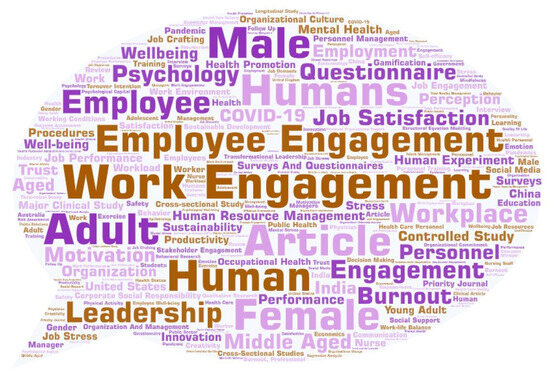
Figure 9.
Keyword analysis in phase I.
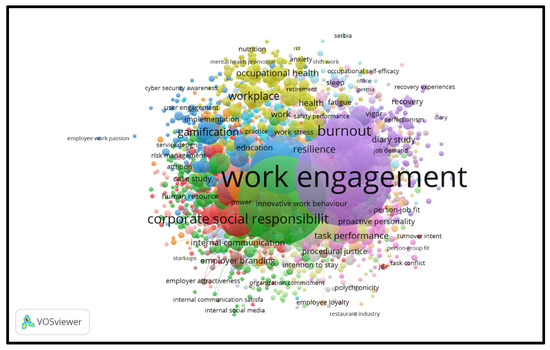
Figure 10.
Network connection of keywords in phase I.
4.2. Phase II: Employee Performance
Scopus, one of the largest and most trustworthy databases, was mined for information in the second stage using the “employee performance” keyword. The “(TITLE-ABS-KEY((“employee” OR “employees”) AND (“performance”)) AND (LIMIT-TO (DOCTYPE, “ar”) OR LIMIT-TO (DOCTYPE, “cp”)) AND (LIMIT-TO (SRCTYPE, “j”) OR LIMIT-TO (SRCTYPE, “p”)) AND (LIMIT-TO (LANGUAGE, “English”)))” string was used by the authors to extract the data in the first pass, and 51,766 articles were extracted from the database. To finalize the corpus for analysis, inclusion/exclusion criteria were applied to extract data in which only English-written articles were included, and the authors removed all the articles with missing information, like author, year, title, etc. Articles published in journals and conferences were considered for the bibliometric analysis. The total number of articles that were eventually analyzed was 42,358.
4.2.1. Publication Timeline Analysis
Since the initial study on employee performance, a consistent upward trend was observed, as illustrated in Figure 11 (1937–2000) and Figure 12 (2001–2023). According to the available evidence, the earliest paper to be published was in 1937, with a single count. The number of published works has grown, which is expected to continue. In 2022, the maximum number of publications was 3674, 8.7% of total publications. As the data are taken till the third quarter of 2023 and until 3224 articles are published, more articles in this domain are expected to be published in the coming years.
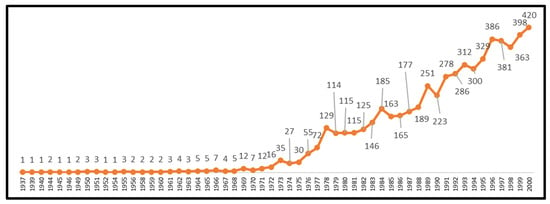
Figure 11.
Publication timeline (1937–2000) of phase II.
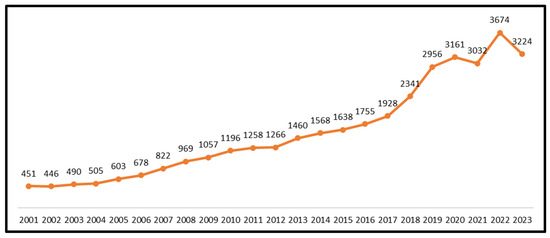
Figure 12.
Publication timeline (2001–2023) of phase II.
4.2.2. Subject-Wise Analysis
Figure 13 depicts the rising trends related to the subject-wise analysis. This analysis provides evidence that the research in the different domains is expected, and as the analysis shows, the maximum publications are from the business management domains. Accounting is a subject area with 19,859 publications, which is 46.88% of total publications, and furthermore, social sciences is the subject area where the authors received 9493 publications.
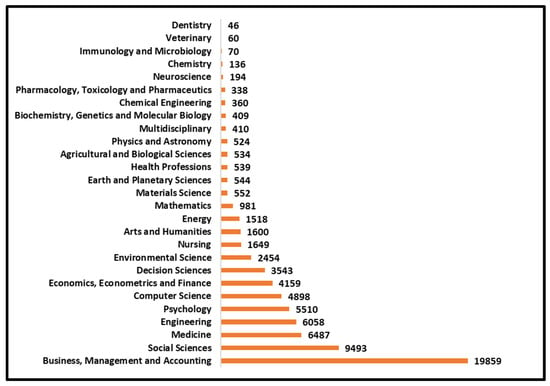
Figure 13.
Subject area analysis of phase II.
4.2.3. Source-Wise Analysis
In this research, the author considered only articles from journals and conferences. A total of 36,661 articles are published in journals, 86.55%, while 5697 are published in conferences. In journals, 11,248 articles are published on open access platforms, 26.55% of the publications. There are 4906 gold, open access, 1290 hybrid gold, 2383 bronze, and 6598 green publications. The analysis of the published research based on the journals and conferences is depicted in Figure 14. The bar chart is based on the number of articles, citations, and impact factor of the journal or conference, which was collected from the journal websites in May 2025. According to the data, the Journal of Applied Psychology leads the board with 624 articles. This journal has an impact factor of 9.4. Sustainability is a journal that is on the board in second position with a count of 546. This journal has an impact factor of 3.3.
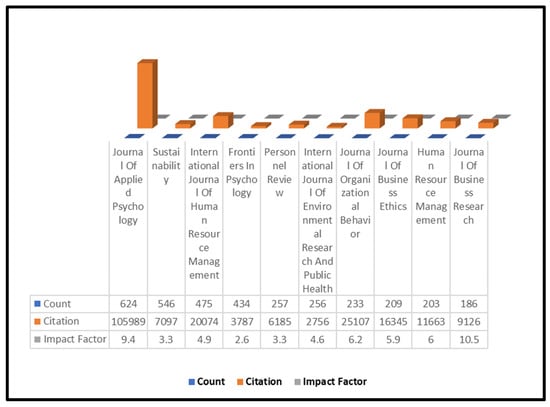
Figure 14.
Journal-wise analysis of phase II.
4.2.4. Country Analysis
Table 3 represents the analysis of countries based on publications and citations. The analysis shows that the United States leads the board with 11,364 articles and a citation count of 502,019, when it comes to the number of publications based on citations. China is ranked second based on its publications with 3352 counts, and the United Kingdom is ranked second based on 2963 citations.

Table 3.
Countries’ contribution based on the publications and citations in phase II.
Different countries are connected in terms of their research articles, and Figure 15 depicts the interconnection of different countries regarding their research documents. Each link is provided a positive number representing its “link strength.” The higher this number is, the tighter the bond. The link strength between the two keywords is represented by the number of times the two keywords appear together in a publication. Figure 15 displays the results of this analysis, which indicates that the United States has the most influential publications (11,364), the most citations (502,019), and the most vital links (3664). In second place is China, with 3352 published articles, 54,991 citations, and a link strength of 2233.
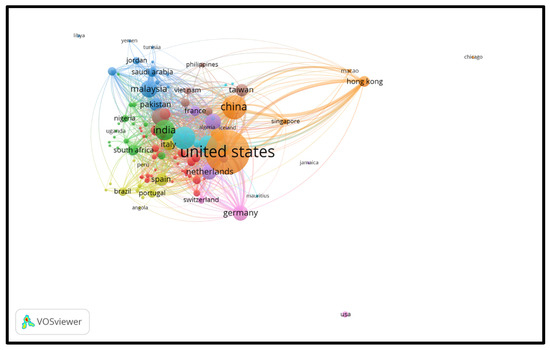
Figure 15.
Countries’ network connection analysis of phase II.
4.2.5. Keyword Analysis
Keywords are an essential part of any article, and the leading keywords based on their count are represented in Figure 16. This graphical depiction helps in identifying the core focus areas and recurring themes within the field. “Performance” is the keyword that originated in 2010 and has a link strength of 6090. The article’s keyword network analysis is depicted in Figure 17. Performance, job satisfaction, job performance, employee performance, and organizational performance are the top keywords used by various researchers in their research. These are the top-tier keywords based on their frequency and relative link authority. All keywords are directly or indirectly connected through their inbound connection, which is represented as the link strength of their connection. In addition, the graph uses a wide range of colors to highlight particular data points or patterns and make it easier to differentiate between the different data sets visually. This may make it simpler to understand the data displayed in the graph.
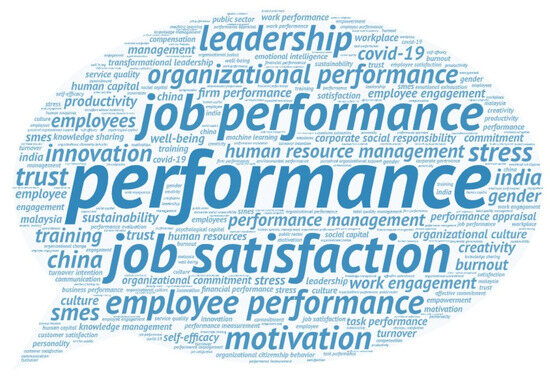
Figure 16.
Keyword analysis of phase II.
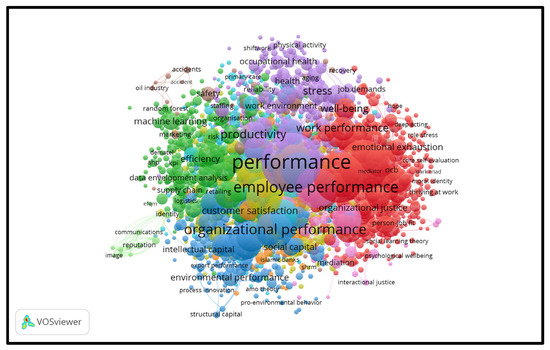
Figure 17.
Network connection of keywords in phase II.
4.3. Phase III: Employee Engagement and Employee Performance with Artificial Intelligence
In phase III, the author analyzed artificial intelligence involvement with employee engagement and performance. The author used the “(TITLE-ABS-KEY((“employee” OR “employees”) AND (“performance” OR “engagement”) AND (“Artificial Intelligence” OR “AI”)) AND (LIMIT-TO (LANGUAGE,”English”)))” string to extract the data from the Scopus database, which is one of the largest and most reliable databases. In the first pass, 619 articles were extracted from the database. Inclusion/exclusion criteria were applied to the extracted data, and only articles published in English were considered for the final corpus. At the same time, the authors excluded articles with incomplete metadata (e.g., missing author, year, title, etc.). The total number of articles counted for this study came to 606.
4.3.1. Publication Timeline Analysis
Figure 18 shows a rising trend over the years following the publication of the first paper on employee engagement and performance using AI. From 1984 to now, only a single paper has been published in the AI period, despite the general upward trend in the number of publications in this field. In 2022, the maximum number of publications was 148, which was 24.42% of the total. As the data are taken till the third quarter of 2023 and 133 articles are published, more articles in this domain are expected in the coming years.
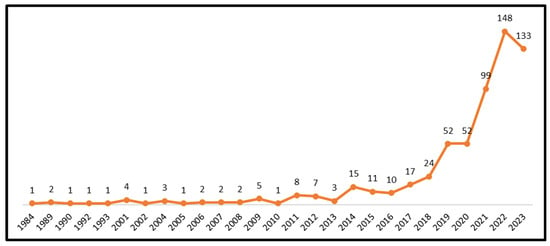
Figure 18.
Publication timeline of phase III.
4.3.2. Subject-Wise Analysis
Figure 19 depicts the subject-wise trend analysis. Due to its place in management and computer science, this figure illustrates the anticipated research in many disciplines. There are more articles in the computer science and engineering category than any other, with 319 devoted to computing alone and only 204 to business administration.
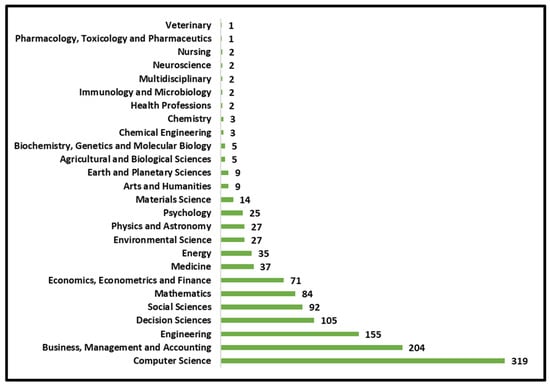
Figure 19.
Subject area analysis of phase III.
4.3.3. Source-Wise Analysis
Figure 20 represents a source-wise rising trend. Figure 20 shows that the research published on employee engagement and performance with AI is significantly less in conference review papers and other peer-reviewed articles. A total of 290 articles are published in journals, which is 47.85% of the total publications. In journals, 181 articles are published on open access platforms, which is 29.86% of the publications. There are 73 open access, gold publications, 33 hybrid gold, 41 bronze, and 85 green.
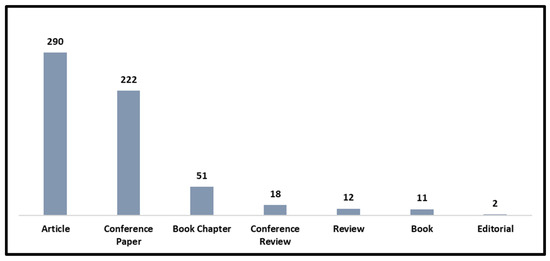
Figure 20.
Source-wise analysis of phase III.
4.3.4. Journal-Wise Analysis
The analysis for the published research based on the journals and conferences is depicted in Figure 21. The bar chart is based on the count of articles and citations of journals/conferences. According to the data from conferences, Lecture Notes in Computer Science leads the board with 27 articles, and Advances in Intelligent Systems and Computing is in second position with 13 articles. All analyzed data show that they belong to a conference or book series that does not have an impact factor.
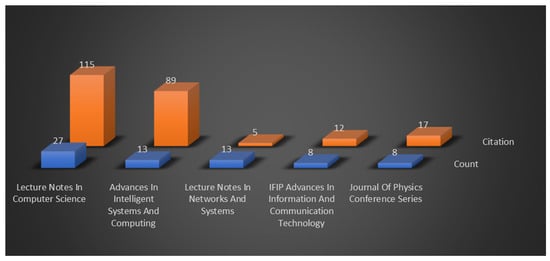
Figure 21.
Journal-wise analysis of phase III.
4.3.5. Country Analysis
The corpus selected for analysis consisted of 606 articles, so the authors have fewer publications. Table 4 represents the analysis of countries based on publications and citations. An analysis shows that India leads the board with 118 articles and 788 citations when it comes to the number of publications. Regarding the analysis based on the citations, the United States leads the board with 95 articles with 1511 citations. The United States is in second place regarding the number of publications, and India is in second place regarding citations.

Table 4.
Countries’ contribution based on the publications and citations in phase III.
Figure 22 represents the network graph of countries based on their research documents. A positive numerical value is assigned for each link, described as the link strength. The stronger the connection, the higher this number should be. The number of times two keywords appearing together in a publication is reflected in the total link strength. This analysis states that India has the most significant publications of 118, 788 citations, and a link strength of 50, as shown in Figure 22. The United States is a distant second, with 95 publications and 1511 citations, with a link strength of 64. The United Kingdom is in third place with 31 publications and 736 citations. At the same time, China is in third position with 67 articles and 430 citations in terms of publications.
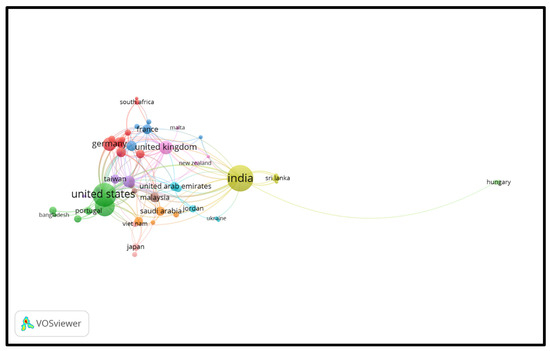
Figure 22.
Countries’ network connections in phase III.
4.3.6. Keyword Analysis
Figure 23 provides a visual representation of the most commonly used keywords by the author in their studies. “Artificial Intelligence” is the keyword that occurs 353 times and has a link strength of 384. The article’s keyword network analysis is depicted in Figure 24. Artificial intelligence, machine learning, deep learning, employee engagement, and human resource management are the top keywords used by various researchers in their research. These are the keywords that are considered the most prominent based on their occurrence and link strength. When discussing keywords, “link strength” can mean the quantity and quality of inbound links to a document and the “keywords” of that material appearing in the linked text. In addition, a wide range of colors is used in the graph to draw attention to specific data points or trends or to help visually distinguish between the various data sets. There is a chance this might make the data displayed on the graph less complicated to read and evaluate. To put it another way, terms like “AI in Human Resources,” “Adult”, “AIML”, and “etc.”, are just some of the author keywords that have been used exactly once and have one link strength.
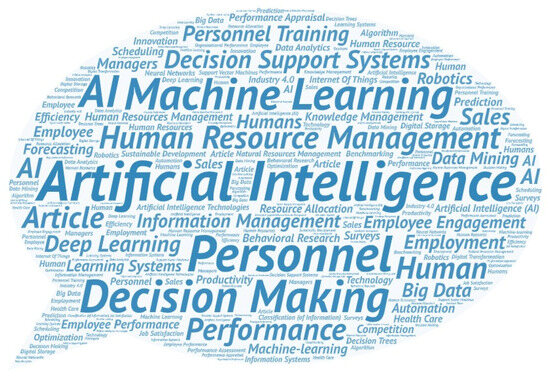
Figure 23.
Keyword analysis of phase III.
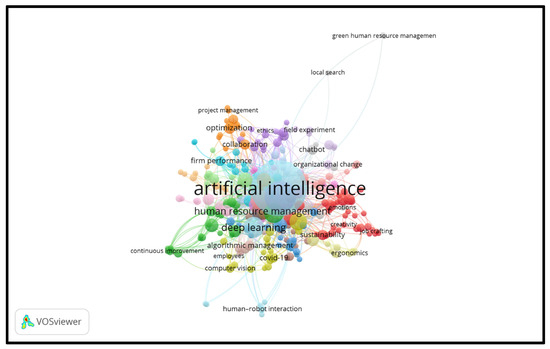
Figure 24.
Network connection of keywords in phase III.
The empirical findings reveal a steady increase in the research output on employee engagement and performance, with a particularly sharp rise in AI-related studies post-2020. This confirms the prior predictions by [11] that organizations are rapidly pivoting toward AI-enabled HR solutions. However, our bibliometric evidence also shows the fragmented integration of AI with traditional human resource theories—especially regarding the role of leadership. While transformational leadership frequently appears in high-citation studies, it remains underexamined in AI-related empirical contexts, creating a disconnection between theoretical propositions and practical implementation. The bibliometric analysis identified the United States, India, and China as predominant contributors to publication volume and citation count; nevertheless, a thorough investigation of keyword co-occurrences and the research focus uncovers developing regional disparities. The research conducted in the United States often highlights transformational leadership, psychological engagement, and ethical governance of artificial intelligence, demonstrating a foundation rooted in organizational behavior and human-centered design. Conversely, Indian and Chinese research frequently emphasize the importance of AI in enhancing operational efficiency, performance analytics, and digital HRM transformation, reflecting a more technologically instrumental viewpoint. These disparities correspond with overarching contextual elements, including labor market dynamics, corporate culture, and the preparedness of digital infrastructure. Although the authors did not discern fully developed “national schools of thought,” these theme variations highlight the significance of regional context in influencing AI-driven HR practices. This regional perspective enhances the interpretive value and provides practical insights for customizing employee engagement techniques to particular national and organizational contexts. Table 5 highlights the thematic emphases, underlying theoretical orientations, and recurring focus keywords across leading contributing countries, illustrating how regional contexts influence the conceptual framing of AI’s role in HRM.

Table 5.
National-level thematic distinctions in AI-mediated employee engagement and performance research.
5. Limitations of This Study
Searching Scopus with the different strings taken into consideration by the authors may not have returned all of the papers related to employee engagement, employee performance, and their relationship with AI. Regardless of how large the sample was, there is a chance that the current study may not fully capture the breadth of the relevant literature. Limitations in search terms, synonyms, string construction, search engine variety, and the correct rejection of the results for which the search string is insufficient all contribute to a poor retrieval of the literature corpus. Remembering that search terms and phrases may initially eliminate useful functional research is vital. The next step is for the authors to use these terms to determine the most valuable classifications for readers in the research, academic, and practical communities. There may be additional data and comparisons of methods in the future as the authors try to keep up with the exponential data growth. This work hints at plans to compare many databases, including Scopus and the Web of Science. It has been found that the greater the number of scientific publications in a study, the more credible the study’s overall findings. An innovative classification approach for researching labor trends and advancements needs further investigation. Since just one VOSviewer application was employed in this study, future investigations may benefit from using different bibliometric analysis techniques.
6. Discussion
Artificial intelligence (AI) and machine learning (ML) are at the heart of employee engagement and performance solutions, which aim to boost morale, output, and efficiency in the workplace. These tools help employees better understand the organization, pinpoint problem areas, and launch data-driven improvement projects. Artificial intelligence (AI) can anticipate future trends, evaluate employee input, provide individualized recommendations, track real-time performance, and identify skill gaps. It can also assess employee well-being by examining factors like their stress levels, job hours, and work–life balance. Chatbots and virtual assistants powered by artificial intelligence (AI) can improve the management of HR questions, workforce planning effectiveness, and diversity and inclusion efforts. Performance reward and recognition programs can be created and implemented more quickly and efficiently with the help of artificial intelligence (AI). In addition, AI-enabled predicted turnover research may accurately pinpoint workers more likely to leave their positions voluntarily. However, combining AI with human connection, empathy, and communication is essential to create a pleasant workplace. Data privacy and ethical considerations must be prioritized during the rollout of AI-powered solutions designed to boost employee motivation and productivity. This bibliometric analysis reveals a significant rise in the scholarly interest about the correlation between employee engagement, performance, and artificial intelligence (AI) from 2020. The data suggest that AI can enhance operational efficiency and production; nevertheless, they also highlight considerable shortcomings, including the lack of human-centered elements, such as organizational culture and leadership. Prior research has established that transformational leadership is essential for managing digital transition [13,14]. Nonetheless, it remains insufficiently represented in the empirical research primarily focused on AI. This discrepancy suggests that the chance to connect leadership styles with effective AI adoption and sustained employee engagement was missed. Furthermore, previous studies have shown that confidence, job autonomy, and organizational support are essential elements of engagement; nevertheless, these qualities are insufficiently reflected in AI-related terminology or citation networks. The predominant focus of the literature is on technology, sometimes neglecting the social, emotional, and ethical ramifications of the digital revolution. The higher frequency of research publications in India compared to the United States, coupled with its lower citation rate, suggests differences in theoretical development and worldwide influence. To rectify these weaknesses, future research must include leadership, employee well-being, and ethical frameworks alongside the evaluation of system efficacy. To utilize AI responsibly and efficiently, organizations need acquire a comprehensive grasp of how AI impacts human behavior, leadership styles, and cultural contexts.
7. Implications
Optimizing the benefits of AI within an organizational environment requires a diversified approach that integrates insights from various disciplines due to the complex nature of AI–employee interaction. The keyword network analysis indicates that although core concepts, such as “employee performance” and “AI”, are tightly linked, critical mediators, like “leadership,” “employee well-being,” and “organizational culture”, are underrepresented. This diverges from prior studies that emphasize the socio-emotional impact of digital transformation on employees [39]. As such, while the data suggest AI adoption correlates with performance gains, it also implies a research gap in understanding how these gains are achieved and under what conditions they are sustainable. These insights reinforce the importance of viewing AI not merely as a technical upgrade, but as part of a broader organizational change process requiring supportive leadership and strategic alignment. Ethical considerations are emphasized, particularly on the ideals of fairness, transparency, and the well-being of employees in AI-driven endeavors. This exploratory bibliometric study is valuable for academics, practitioners, and businesses considering using AI to boost workplace morale and productivity. It sheds light on the current state of the research and provides a roadmap for future research in this critical domain. This research proposes methodologies for enterprises, human resources professionals, and policymakers to leverage AI to improve employee engagement and performance. It proposes the creation of AI-integrated engagement frameworks that harmonize automation with human-centric principles, the deployment of AI-driven feedback mechanisms, and the establishment of adaptive performance management systems. It is advisable to use transformational leadership techniques, including educating leaders to serve as change agents and emphasizing staff reskilling and upskilling initiatives. Implementation protocols must encompass leadership development seminars, AI readiness evaluations, and audits of ethical AI usage to promote innovation and adaptation. This research enhances the current understanding of three primary theoretical domains. Initially, it enhances the convergence of AI and human resource management by delineating the research trajectories and pinpointing the underexamined yet vital links between AI implementation, employee experience, and leadership. Secondly, it enhances the organizational behavior theory by suggesting that AI’s influence is not deterministic but rather modulated by leadership style, culture, and ethical considerations, thereby promoting a more nuanced and contextual understanding of digital transformation. Third, the bibliometric framework constitutes a methodological addition by providing a reproducible way for assessing interdisciplinary fields across temporal and geographic dimensions.
8. Conclusions and Future Directions
This research provides a bibliometric exploration of the literature on AI-based employee engagement and performance. The data show that scholarly interest in this field has recently increased, as shown by an uptick in publications and the formation of new networks for interdisciplinary research. Multidisciplinary teamwork is highlighted, as is the need for businesses and universities to align their plans with the current areas of research interest. The diversity of countries represented by the research participants highlights the importance of international cooperation and knowledge sharing in artificial intelligence-based employee engagement and performance. This study meticulously examined the material on employee performance and engagement concerning artificial intelligence integration. Comprising three sections, this study highlights the growing interest in this junction driven by technology developments and the urgent need to understand the human consequences of digital transformation. Critical observations show the predominance of transformational leadership as a possible facilitator of favorable AI results, a regional disparity in research productivity and impact, and significant shortcomings in including ethical, emotional, and cultural considerations into AI-HR conversations. This research indicates that although artificial intelligence can raise employee performance and engagement, its effectiveness depends much on human-centered design, enabling leadership, and organizational readiness. Stakeholders have to go beyond the technological story and support projects combining openness, inclusivity, and confidence at all phases of artificial intelligence deployment. These findings indicate that national contexts shape not only the volume of AI-related HRM research, but also the conceptual frameworks employed. Recognizing such regional perspectives is vital for developing culturally adaptable and theoretically robust AI-in-HR strategies. Future research should consider a multi-database approach, like Web of Science or Dimensions; include qualitative meta-analyses; and explore AI’s impact on specific sectors, such as healthcare or education. Longitudinal studies that assess how leadership styles influence AI adoption over time, and how AI tools reshape employee perceptions, would offer deeper insights into sustainable implementation models.
Author Contributions
C.S.: conceptualization, data collection, writing, analysis. N.C.: writing, project administration, referencing. H.-Y.C.: proofreading, validation, writing and reviewing. All authors have read and agreed to the published version of the manuscript.
Funding
This research received no external funding.
Institutional Review Board Statement
Not Applicable.
Informed Consent Statement
Not Applicable.
Data Availability Statement
Data will be available on request.
Conflicts of Interest
The authors have no competing interests to declare relevant to this article’s content.
References
- Sharma, C.; Ahmad, S.; Singh, S. Impact of Human Resource Practices on Individual and Organization Growth. In Proceedings of the 2022 International Conference on Decision Aid Sciences and Applications (DASA), Chiangrai, Thailand, 23–25 March 2022; pp. 937–941. [Google Scholar]
- Sharma, C.; Sakshi; Sharma, S.; Kondal, N. Role and impact of human resource information system (HRIS) on organizational activities. AIP Conf. Proc. 2023, 2558, 20070. [Google Scholar]
- Singh, R.; Ramdeo, S. Conclusions and Future Research Directions in Human Resource Management and Organizational Behavior. In Contemporary Perspectives in Human Resource Management and Organizational Behavior; Palgrave Macmillan: London, UK, 2023; pp. 209–220. [Google Scholar]
- Anakpo, G.; Nqwayibana, Z.; Mishi, S. The Impact of Work-from-Home on Employee Performance and Productivity: A Systematic Review. Sustainability 2023, 15, 4529. [Google Scholar] [CrossRef]
- Michulek, J.; Gajanova, L.; Krizanova, A.; Nadanyiova, M. Determinants of improving the relationship between corporate culture and work performance: Illusion or reality of serial mediation of leadership and work engagement in a crisis period? Front. Psychol. 2023, 14, 1135199. [Google Scholar] [CrossRef] [PubMed]
- Adanlawo, E.F.; Nkomo, N.Y.; Vezi-Magigaba, M.F. Compensation as a motivating factor of job satisfaction and performance. Int. J. Res. Bus. Soc. Sci. 2023, 12, 131–139. [Google Scholar] [CrossRef]
- Madero-Gómez, S.M.; Leal, Y.L.R.; Olivas-Luján, M.; Yusliza, M.Y. Companies Could Benefit When They Focus on Employee Wellbeing and the Environment: A Systematic Review of Sustainable Human Resource Management. Sustainability 2023, 15, 5435. [Google Scholar] [CrossRef]
- Riehle, R.; Wieser, V.E.; Hemetsberger, A. ‘We truly love what we do’: The Tribal Consumer Inside Passionate Service Employees. J. Serv. Res. 2023, 27, 559–578. [Google Scholar] [CrossRef]
- Turyadi, I.; Zulkifli, Z.; Tawil, M.R.; Ali, H.; Sadikin, A. The Role of Digital Leadership in Organizations to Improve Employee Performance and Business Success. J. Ekon. 2023, 12, 1671–1677. [Google Scholar]
- Jiang, Y.; Ritchie, B.W.; Verreynne, M.-L. Building dynamic capabilities in tourism organisations for disaster management: Enablers and barriers. J. Sustain. Tour. 2023, 31, 971–996. [Google Scholar] [CrossRef]
- Chowdhury, S.; Dey, P.; Joel-Edgar, S.; Bhattacharya, S.; Rodriguez-Espindola, O.; Abadie, A.; Truong, L. Unlocking the value of artificial intelligence in human resource management through AI capability framework. Hum. Resour. Manag. Rev. 2022, 33, 100899. [Google Scholar] [CrossRef]
- Malik, A.; Sharma, S.; Batra, I.; Sharma, C.; Kaswan, M.S.; Garza-Reyes, J.A. Industrial revolution and environmental sustainability: An analytical interpretation of research constituents in Industry 4.0. Int. J. Lean Six Sigma 2023, 15, 22–49. [Google Scholar] [CrossRef]
- Odugbesan, J.A.; Aghazadeh, S.; Al Qaralleh, R.E.; Sogeke, O.S. Green talent management and employees’ innovative work behavior: The roles of artificial intelligence and transformational leadership. J. Knowl. Manag. 2023, 27, 696–716. [Google Scholar] [CrossRef]
- Abbas, A.; Suhariadi, F.; Ekowati, D.; Fenitra, R.M. A Strategic Paradigm for Transformational Leadership Theory in the Digital Age: Scope of the Analytical Third. In Transformational Leadership Styles for Global Leaders: Management and Communication Strategies; IGI Global: New York, NY, USA, 2023; pp. 304–323. [Google Scholar]
- Graham, S.; Cadden, T.; Treacy, R. Examining the influence of employee engagement in supporting the implementation of green supply chain management practices: A green human resource management perspective. Bus. Strateg. Environ. 2023, 32, 4750–4766. [Google Scholar] [CrossRef]
- Alolayyan, M.N.; Alyahya, M.S. Operational flexibility impact on hospital performance through the roles of employee engagement and management capability. BMC Health Serv. Res. 2023, 23, 19. [Google Scholar] [CrossRef] [PubMed]
- Mozammel, S. Job Performance through Job security and Organizational support: Testing the Mediation of Employee Engagement. Int. J. Oper. Quant. Manag. 2023, 29, 1–13. [Google Scholar]
- Boccoli, G.; Gastaldi, L.; Corso, M. The evolution of employee engagement: Towards a social and contextual construct for balancing individual performance and wellbeing dynamically. Int. J. Manag. Rev. 2023, 25, 75–98. [Google Scholar] [CrossRef]
- Zhao, X.; Wang, J.; Mattila, A.; Leong, A.M.W.; Cui, Z.; Sun, Z.; Yang, C.; Chen, Y. Examining the cross-level mechanisms of the influence of supervisors’ job crafting on frontline employees’ engagement and performance. Int. J. Contemp. Hosp. Manag. 2023, 35, 4428–4450. [Google Scholar] [CrossRef]
- Susanto, P.C.; Syailendra, S.; Suryawan, R.F. Determination of Motivation and Performance: Analysis of Job Satisfaction, Employee Engagement and Leadership. Int. J. Bus. Appl. Econ. 2023, 2, 59–68. [Google Scholar] [CrossRef]
- Sahut, J.M.; Lissillour, R. The adoption of remote work platforms after the Covid-19 lockdown: New approach, new evidence. J. Bus. Res. 2023, 154, 113345. [Google Scholar] [CrossRef]
- Cheng, F.-F.; Huang, Y.-W.; Yu, H.-C.; Wu, C.-S. Mapping knowledge structure by keyword co-occurrence and social network analysis: Evidence from Library Hi Tech between 2006 and 2017. Libr. Hi Tech 2018, 36, 636–650. [Google Scholar] [CrossRef]
- Chen, C. Science mapping: A systematic review of the literature. J. Data Inf. Sci. 2017, 2, 1–40. [Google Scholar] [CrossRef]
- Cobo, M.J.; López-Herrera, A.G.; Herrera-Viedma, E.; Herrera, F. Science mapping software tools: Review, analysis, and cooperative study among tools. J. Am. Soc. Inf. Sci. Technol. 2011, 62, 1382–1402. [Google Scholar] [CrossRef]
- Thelwall, M. Introduction to Webometrics: Quantitative Web Research for the Social Sciences; Synthesis Lectures on Information Concepts, Retrieval, and Services; Morgan & Claypool: San Rafael, CA, USA, 2009; pp. 1–116. [Google Scholar]
- Björneborn, L.; Ingwersen, P. Toward a basic framework for webometrics. J. Am. Soc. Inf. Sci. Technol. 2004, 55, 1216–1227. [Google Scholar] [CrossRef]
- Kwok, R. Research impact: Altmetrics make their mark. Nature 2013, 500, 491–493. [Google Scholar] [CrossRef] [PubMed]
- Erdt, M.; Nagarajan, A.; Sin, S.-C.J.; Theng, Y.-L. Altmetrics: An analysis of the state-of-the-art in measuring research impact on social media. Scientometrics 2016, 109, 1117–1166. [Google Scholar] [CrossRef]
- Piwowar, H. Introduction altmetrics: What, why and where? Bull. Am. Soc. Inf. Sci. Technol. 2013, 39, 8–9. [Google Scholar] [CrossRef]
- Chan, T.M.; Kuehl, D.R. On lampposts, sneetches, and stars: A call to go beyond bibliometrics for determining academic value. Acad. Emerg. Med. 2019, 26, 688–694. [Google Scholar] [CrossRef]
- Kamdem, J.P.; Duarte, A.E.; Lima, K.R.R.; Rocha, J.B.T.; Hassan, W.; Barros, L.M.; Roeder, T.; Tsopmo, A. Research trends in food chemistry: A bibliometric review of its 40 years anniversary (1976–2016). Food Chem. 2019, 294, 448–457. [Google Scholar] [CrossRef]
- Jain, S.; Sharma, C.; Das, P.; Shambhu, S.; Chen, H.-Y. Blockchain and Cryptocurrency: A Bibliometric Analysis. J. Adv. Comput. Intell. Intell. Inform. 2023, 27, 822–836. [Google Scholar] [CrossRef]
- Wang, X.; Xu, Z.; Škare, M. A bibliometric analysis of Economic Research-Ekonomska Istra zivanja (2007–2019). Econ. Res. 2020, 33, 865–886. [Google Scholar]
- Chen, X.; Liu, Y. Visualization analysis of high-speed railway research based on CiteSpace. Transp. Policy 2020, 85, 1–17. [Google Scholar] [CrossRef]
- Singh, S.; Sharma, C.; Bali, P.; Sharma, S.; Shah, M.A. Making sense of glass ceiling: A bibliometric analysis of conceptual framework, intellectual structure and research publications. Cogent Soc. Sci. 2023, 9, 2181508. [Google Scholar] [CrossRef]
- Yu, Y.; Li, Y.; Zhang, Z.; Gu, Z.; Zhong, H.; Zha, Q.; Yang, L.; Zhu, C.; Chen, E. A bibliometric analysis using VOSviewer of publications on COVID-19. Ann. Transl. Med. 2020, 8, 816. [Google Scholar] [CrossRef] [PubMed]
- Donthu, N.; Kumar, S.; Pattnaik, D. Forty-five years of journal of business research: A bibliometric analysis. J. Bus. Res. 2020, 109, 1–14. [Google Scholar] [CrossRef]
- Sharma, C.; Sakhuja, S.; Nijjer, S. Recent trends of green human resource management: Text mining and network analysis. Environ. Sci. Pollut. Res. 2022, 29, 84916–84935. [Google Scholar] [CrossRef]
- Ribeiro, N.; Gomes, D.; Oliveira, A.R.; Semedo, A.S.D. The impact of the work-family conflict on employee engagement, performance, and turnover intention. Int. J. Organ. Anal. 2023, 31, 533–549. [Google Scholar] [CrossRef]
Disclaimer/Publisher’s Note: The statements, opinions and data contained in all publications are solely those of the individual author(s) and contributor(s) and not of MDPI and/or the editor(s). MDPI and/or the editor(s) disclaim responsibility for any injury to people or property resulting from any ideas, methods, instructions or products referred to in the content. |
© 2025 by the authors. Licensee MDPI, Basel, Switzerland. This article is an open access article distributed under the terms and conditions of the Creative Commons Attribution (CC BY) license (https://creativecommons.org/licenses/by/4.0/).